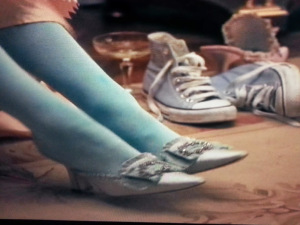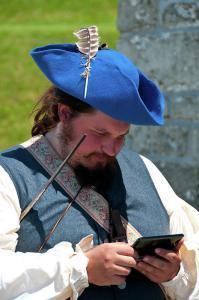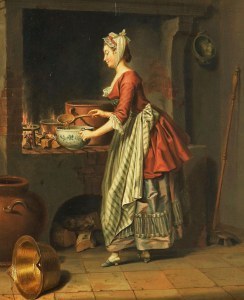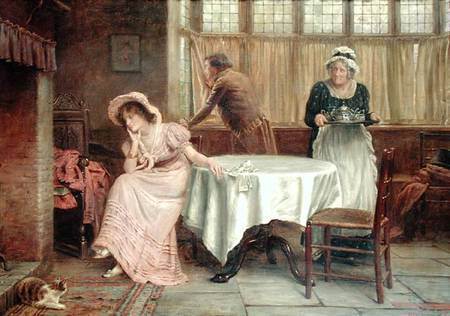Jude Knight's Blog, page 151
February 3, 2015
What’s in a word? Authentic language in historical fiction
One of the challenges facing a writer of historical fiction is that our language keeps changing. In 2015, our vocabulary, our speech patterns, and our tolerance for formal grammar conventions are all very different to what they were 200 years ago, or even 100. We need:
to use words that were in use at the time, but that modern readers will understand
write dialogue that sounds authentic, but that is also easy to read for modern readers.
Ian Reid, in his blog Reid on Writing, talks about:
…the challenge of creating a language that achieves verisimilitude – the semblance of reality. It’s no easy matter to persuade your readers that your narrative medium is rendering accurately how people spoke and wrote in your chosen period and place. The writing must seem to embody their characteristic turns of phrase, their conversational habits, the structure of their sentences – not only to avoid anachronism but also to gain an insight into the way they thought and felt, which would sometimes have been different from what we’re used to today. So meticulous attention to language isn’t pedantic in novels of this kind – it’s vital for credibility. But it needs to be done in a manner that avoids weighing down the story and slowing down the reader.
And John Yeoman points out that such language must not sound too modern to modern ears.
If the reader detects a linguistic howler in our work (although the reader may be wrong), the illusion is shattered. When I had a character in my last Elizabethan novel abandon his ‘go cart’ to ‘jet’ about Europe, arrive in England by ‘bus’, take his ‘train’ to Slough, then leave his ‘car’ at Ivinghoe, some critics chided me for my anachronisms.
Nonsense! I was simply being faithful to the everyday language of the 1590s. Those terms, surprisingly, were associated with transport in the period. The truly erudite reader, I felt, would have understood (and chortled). But s/he didn’t. In the reader’s view, I had committed five howlers.
When I was researching for this post, the word I kept coming across was ‘authenticity’. We simply cannot accurately reproduce the language of the past. What we can do is give the readers a flavour of the past; a sense of authenticity. This becomes more and more acute (as Lynn Shepherd points out in a blog post on authenticity) as we go further back in time:
People in the past didn’t just dress differently from us, they talked differently too, and that difference gets wider the further back you go. And at some point – probably around the year 1500 – authenticity of language becomes literally impossible: if you’re writing about the Trojan war you simply can’t do your dialogue in Ancient Greek, any more than a character like Cadfael can speak in Middle English (or, indeed, medieval Welsh). So some sort of compromise has to be found.
Do you opt for a style that conveys some notion of the period, or take the view that your characters would have spoken the ‘ordinary English’ of their time, so allow them to use ‘ordinary English’ as spoken now? I’ve seen both approaches – and many variants in between – and each has both pros and pitfalls. The danger with the former is what I call Forsooth Syndrome, in which you end up with characters spouting a queasy mixture of contemporary English liberally sprinkled with cod words and phrases designed to give a period feel. It can sound very phoney – a bit like a newly-built pub decked out with reproduction horse brasses. But going for the full-on modern-English-and-be-damned approach does make the task of creating that elusive ‘atmosphere’ all the harder.
I’ve tried to keep my vocabulary authentic. I’ve used contractions in my general descriptions, but not in the conversation of my upper-class ladies (except in moments of great stress). Otherwise, I think my writing is modern in style. I hope I’ve done enough to give an authentic early 19th century flavour to my writing.
To keep the vocabulary authentic has meant researching all sorts of unusual topics, such as what words were used for intimacy in my time period. And where I’ve failed, I’ve been ably supported by my excellent proofreader, who has highlighted and questioned words that felt modern to her.
Yesterday, she sent me a link to a resource Mary Robinette Kowal created when writing her Regency Magic series. It is a list of all the words Jane Austen used: 14,793 of them. She has generously posted it on her website, as a text file and as a plugin for Open Office. If you’re writing in the late Georgian or Regency era, go take a look. (And if you haven’t read Kowal’s Glamourist histories, do yourself a favour and check them out.)



February 2, 2015
What to do with a bad review
 I’m thinking about bad reviews this week, because — after a dream run for Candle’s Christmas Chair and over 80 reviews — I have my first two really negative ones. I’ve had some people make critical remarks, and some give low ratings, but the novella has not been truly panned till this week.
I’m thinking about bad reviews this week, because — after a dream run for Candle’s Christmas Chair and over 80 reviews — I have my first two really negative ones. I’ve had some people make critical remarks, and some give low ratings, but the novella has not been truly panned till this week.
What do you do with a bad review? Some people have tantrums. Some weep. Some sigh philosophically and move on. I research and turn it into a blog post. I know! Right?
Steve Aedy, in a guest post on Book Baby, gives three reasons why a bad review is good.
Reason one is that you might be able to learn from it:
Sift through all the “I hate this book,” sentiments. Find the real substance of the review – characters are flat, grammar and punctuation wasn’t perfect. Take these tips to heart the next time you pick up your pen. Look for ways to improve your writing.
Reason two is that bad reviews can get your book noticed. And a debate between people who like the book and those who don’t can attract even more attention. Even bad reviews, then,boost book awareness. Aedy points to the example of 50 shades of grey; 30% of the reviews on Amazon are negative.
Reason three is that bad reviews enhance Search engine optimisation.(SEO)
Every time someone posts a link to your website on their website, it makes Google happy. This happiness results in SEO. Google doesn’t care about the reviewer’s scathing remarks. All Google cares about is the link that reviewer posted.
I found a fourth reason. A bad review gives your good reviews credibility, making it clear to readers that your reviewers aren’t just your Mum in multiple identities.
And a fifth. A bad review that specifies exactly what the reader doesn’t like may attract a reader that loves books just like yours. Your reviewer hates time travel books by means of a magic-wielding cat, and can’t stand wise-cracking heroes and super smart heroines? And they say so? They’ve just marketed your book to those who were searching for all those elements.
Carol Pinchevsky has some advice for new authors.gleaned from interviews with some of sf’s great, all of whom have had bad reviews.
- Think about what the critic is saying.
Carey says, “Obviously, my intention [to deconstruct Tolkienesque epic fantasy] wasn’t clear to that reviewer, so the comment is constructive in terms of forcing me to think about how I could have better executed my idea.”
Brin says, “No matter how good you are, there is always some way to become ‘even better.’ Hence you need to be open to the bad news, as well as the good.” Brin believes in this enough to create his own acronym: CITOKATE (“Criticism Is the Only Known Antidote to Error”).
- Don’t read reviews:
Cherryh reads no reviews, neither negative nor positive. “If they’re good, I might divert my writing to try to please. If they’re bad, I’d feel bad, and maybe be tempted to change my writing to please. In either case, not a good thing.”
- Stay cool.
Carey says, “Readers’ expectations are something authors can’t control…. Taste is personal and reviewers are only human.”
- Remember, it’s nothing personal.
“We review books, not writers,” says Hartwell.
Finally, Pocket full of Books has a regular feature in which they link to authors who have reacted badly to a bad review. Go take a look if you want an example not to follow:
So what did I do about my own two bad reviews?
The first hated the snippets of history, was bored by the use of the language of flowers, and just wanted my hero and heroine to get on with the love story. This reviewer called the novella ‘a total snooze fest’. Best strategy? Ignore. (That said, I’m grateful to the person who posted a five star review on the same site, giving readers two very different opinions to consider.)
The second was on a site that already had a number of positive reviews, and was quite long. Here are some quotes:
‘far too frequent mentions of anatomy and implied love making at the end (married couple).’
‘Min gives in to the hero’s pestering and her baser feelings’.
‘sure [Candle] is kind and caring’
‘some might think his attentions sweet but I found them annoying and over the top’.
On the whole, I think that, if anyone reads the review, such comments are more likely to work for me than against me. Thanks, reviewer.
The reviewer’s most scathing remarks were reserved for a perceived historical error. The review sent me hurrying to check my facts when it claimed that the Roman Baths in Bath were unknown in 1805. I was sure that this claim was wrong, but looked anyway. The discovery was in the 18th Century. I can only speculate that the reviewer confused the 18th Century with the 1800s.
Phew! I expect I will (and probably have) made mistakes, but I try hard not to, and that one would have hurt.
Enough said, and enough attention paid. Time to get back to writing the next book.



February 1, 2015
What authors do
January 31, 2015
Lydia is bored – an excerpt from Farewell to Kindness
 On this visit to Swinbeck Castle, Lydia was finding the country less boring than usual. Quite apart from the young and lusty lover who kept her amused and the servants scandalised, she was gaining unexpected entertainment from joining the committee that was organising an assembly in the nearby town.
On this visit to Swinbeck Castle, Lydia was finding the country less boring than usual. Quite apart from the young and lusty lover who kept her amused and the servants scandalised, she was gaining unexpected entertainment from joining the committee that was organising an assembly in the nearby town.
She sniggered inwardly. The most recent committee meeting had been particularly funny. The other ranking lady was a nobody from a trade family who had married into a title. Lydia made a point of opposing her at every turn, just for the pleasure of seeing how the other three women, toadies all, coped with trying to please both her and the upstart. The upstart had a higher title, but Lydia had the higher pedigree.
She didn’t attend every meeting, of course. She was on the committee to lend it her name and influence, but the commoners could do the actual work, and she included Lady Upstart Avery, who was as common as muck.
This afternoon, though, there was no meeting and Chirbury’s nephew was asleep in her bed. The game they’d played until dawn had involved a number of challenges for young Nat, sending him running and climbing all over the castle, with the challenges becoming more demanding and the rewards more intimate as the night wore on.
Lydia’s exertions had been confined to the interludes between challenges, and she’d drunk water while he tossed down brandy. She was wide awake and looking for something to do.
After a long soothing bath, she submitted herself to her maid’s hands. This girl was one of Carrington’s cast-offs, and credited Lydia with her change in status. No need to tell the girl that she’d developed too many curves to retain Lord Carrington’s interest. Gratitude made her loyal. And she’d become quite skilled at dressing hair, mending dresses, and creating lotions that softened her mistress’s skin.
Dressed at last, she checked Nat, but he was still asleep. She toyed with the idea of waking him. Still, he’d be of more use well rested.
She frittered away half an hour trying on jewellery. Most of these were family pieces. Her stepson, Tony, had asked for some when he married his little mouse. She told him he could pry them out of her dead, cold hands.
Still, she’d sent him a few pieces when she sent him her daughters. Not the best pieces, of course. But she was grateful that he’d taken his four half-sisters: Carrington’s daughter by his second wife, and her own three girls.
Carrington had not been amused at her decision to send them away five years ago. “Do you think I am a danger to my own daughters?” he challenged her, impaling her with his pale blue eyes. She denied it, of course, but still she knew, deep in her mind, that her intervention had been too late for the step-daughter.
She didn’t dwell on such thoughts. She’d learned as a trembling teenager, offered to Carrington by a debt-ridden brother, not to think about past or future, but to enjoy the moment as well as she could, and to please her husband.
Sending her daughters away was the one time she defied him, and even then, she did it without his knowledge and faced him only when—weeks later—he noticed his daughters were gone.
Though he punished her for her presumption, Carrington didn’t confine her as he promised, or send to bring his daughters back, which was confirmation of a sort, if Lydia cared to think about it.
She did not.



January 30, 2015
The report of ebooks’ death was an exaggeration
Several times a year we’re told that ebooks are dead, that they were a passing craze and the craze is over.
Just before Christmas, a large UK book chain trumpeted the news of a slump in the sales of e-readers. ‘People are going back to print,’ enthused the commenters. On the Mad Genius blog, Cedar Anderson had a terse response.
I’ve got two words for that. One I won’t say, I’m a lady. But as a kid on a farm, I stepped in it a few times.
The other word? Tablets. Well, and phones, but really it’s the same thing.
And we simply do not have the data on how many apps have been downloaded so that people can read on tablets or phones. We have four people at my house this weekend. Three of us have Kindles. Three of us have iPads. Three of us have laptops. Two of us have desktops. Three of us have smartphones. Different combinations of technology, but every device that isn’t an ereader has an ereader app.
Similarly, we do not have accurate data on how many print books are sold.
In other words, all of traditional publishing from the introduction of the returns system in the 1930s to the early part of this century was based on educated guesses by the sales department in consultation with editorial. Not based on actual numbers. Not based on real sales figures. Not based on any kind of fact-based system at all.
The traditional publishing industry is in transition because it’s gotten gobbled up by international conglomerates who need real numbers for their own internal reports. Digital book and online sales actually allow for real numbers. Since the American Booksellers Association has taught independent booksellers how to manage their inventory (at the ABA’s Winter Institute), those booksellers have lowered their returns to a maximum of 25%.
So the traditional publishing data is becoming solid, but it’s not there yet. And because so many people in traditional publishing—particularly those in its upper echelons—have been in the business as long as I have, they’re a lot more accepting of wishy-washy numbers and fake statistics. Reports that have lovely graphics and percentages that seem real are still the norm in this industry, rather than studies based on real methodology. That’s in the process of changing, but it hasn’t yet changed.
A 2009 report from UNESCO says:
The lack of reliable – or even broadly realistic – data and analysis on the world’s book culture and publishing markets has been deplored time and again. Yet, the gap has not been bridged.
Nor are the ebook sales reports from traditional sources without their flaws, as the Author Earnings report for January 2015 says:
Why do [the industry news sites] continue to insist that indie self-published ebooks only make up a tiny share of the market, and cannot possibly account for a significant volume of sales?
The answer is simple. Bad data.
All of these industry pundits rely on three officially-recognized sources of ebook market size estimates and projections: AAP/BISG BookStats, AAP StatShot, and now Nielsen PubTrack.
Each of these sources arrives at their ebook market-size estimates by collecting self-reported data from a small subset of participating publishers (1,919 for BookStats, 1,200 for StatShot, 30 for PubTrack) and then using average per-title sales numbers from those participating publishers to project the size of the entire ebook market. They do this by multiplying those average per-title sales numbers by the number of active ebook ISBNs (International Standard Book Numbers) purchased from Bowker by the many tens of thousands of non-participating publishers and indie self-published authors.
But these figures don’t count ebooks with an ISBNs from other sources (I get mine from the New Zealand National Library) or with no ISBN. Author Earnings reports that 30% of ebooks on Amazon do not have an ISBN, so Amazon ebook sales are at least 30% larger than counted in industry statistics. And Amazon is by far the biggest seller of ebooks.
Here’s the Author Earnings analysis of Amazon sales:
The shonkiness of the data, and the counter evidence freely available, does not prevent print advocates from producing superbly crafted infographics to support their case that ereading has plateaued and that print book sales are up. (It is a nice infographic though, isn’t it? Even if the data is seriously flawed?)
I have loved books my whole life, and I adore the smell of print. But nowadays, I only purchase reference books in print. For fiction, I go ebook all the way. I have a Kindle, and I have both iBooks and Kindle Reader on my iPad. When I travel, I can take a fully recharged Kindle with 600 or more books on it, and read it for five days without recharging. The iPad needs recharging more often, but lets me also keep up with emails and Facebook, take notes in meetings, and write blog posts. What’s not to like?



January 29, 2015
Play the story game with me
January 28, 2015
How historically accurate should historical romance be?
 The question in the title is a perennial favourite for readers and writers alike.
The question in the title is a perennial favourite for readers and writers alike.
Should our characters, our backgrounds, and our plot details be scrupulously accurate to the period in which they are set?
Why write historicals if they’re not set in history?
I’m the first to put my hand up and admit I’m pedantic. I obsess over things like when and how the news of Trafalgar and Nelson’s death arrived in Bath (a plot point in Candle’s Christmas Chair). I’ve written blog posts about:
the number of dukes in the United Kingdom (and the number of people in each other rank of the peerage)
the way I changed my story line to accommodate to accommodate the justice system in the early 19th century
my research into cottage cooking to check that a plot line involving jam would actually work (and, in another blog post, my explorations of the cost of sugar to make sure that the heroine could afford the jam)
a bit of fun with language, when my use of the term c–k to mean a male bird was frowned on by a commenter.
 I care. If someone in a regency novel calls an earl Your Grace, or zips up his trousers, or has been christened Beyonce, I’m going to notice.
I care. If someone in a regency novel calls an earl Your Grace, or zips up his trousers, or has been christened Beyonce, I’m going to notice.
And other readers care, too. I was called out by one reader when a minor character in Candle’s Christmas Chair said he was okay. Quite right, too. Thanks to the magic of ebooks, I was able to remove a word that belonged decades in the future and on the other side of the Atlantic.
History Hoydens makes the following point:
To me, it seems ridiculous to even bother writing “historical fiction” (be it romance, mystery, whathaveyou) if the “historical” part is optional. I know, I know . . . in Romancelandia a lot of the history has become optional: our characters are abnormally clean, have perfect teeth, and somehow our heroes never have the ridiculous haircuts that were in vogue for their age (has anyone ever written or read a medieval hero with a bowl cut?). Is a man with Fabio-locks in the Middle Ages any less offensive than a red silk nighty in Regency England? I think they’re both problematic, both a betrayal of the entire point of the genre…
Perhaps I’m being ridiculous, but the willfully chosen error just gets under my skin and itches like mad! There’s something demeaning about it, something dismissive. Something about it says: It was too much trouble to find a way to make my vision/story work within the framework of history, and rather than alter my vision/story, I chose to alter history instead.
But we’re not writing history books
 On the other hand, we’re writing fiction, not history. And we’re writing fiction for today’s readers, for whom real historical accuracy might be a step too far, as this Heroes and Heartbreaker’s post comments:
On the other hand, we’re writing fiction, not history. And we’re writing fiction for today’s readers, for whom real historical accuracy might be a step too far, as this Heroes and Heartbreaker’s post comments:
…in some cases a too-strict reliance on historical detail can be just as off-putting. A classic example of this phenomenon is Diana Gabaldon’s Outlander, in which hero Jamie gets fed up with heroine Claire’s bad habit of putting his men into mortal danger through her dangerously unpredictable behavior, so he beats her. He beats her! Gabaldon’s response to the clamor around this scene (paraphrased) was “I scrupulously researched every aspect of this book and Jamie’s actions and attitudes are fully consistent with those of a man in that time and place so obviously it’s all good because REALISM!!!” To which I can only reply…yes, from a historic standpoint, Jamie’s actions are unexceptional, but on the other hand this is a book whose plot kicks into gear when the heroine travels backward through time, so…well, I wouldn’t have missed that scene if it weren’t there, is all I’m saying.
Penetrating Analysis makes a compelling case for anachronism that makes the story better for readers.
…historical romance is more beholden to the constraints of the romance genre than it is to the reality of history. While historical fiction may generally aim to simulate the past for readers through painstaking attention to detail, historical romance’s overriding preoccupation is different. Emotional authenticity in the development of the relationship is far more important to the genre than strict fidelity to a historical or geographic setting.
Historical settings open up a range of concerns and possibilities to authors, some because they are similar to the present day and others because they are different. To cite just one example in the latter category, the consequences for unintended pregnancy were much different for an upper-class unmarried woman of Regency England than they are for most twenty-first-century readers. The elevated risks associated with extramarital sex can be used to raise the stakes for heroes and heroines in a way that would be out of place in a contemporary novel.
At the same time, historical settings provide a way to explore themes and issues that are vital to contemporary concerns. The remote past can serve as a safe space in which authors can tackle more sensitive topics without hitting too close to home for readers.
Heroes and heroines with postmodern sensibilities are a natural consequence of being written by authors of the twenty-first century. Expecting writers to purge their work of any trace of modern perspective is unrealistic in a genre predicated upon the reader’s connection to the novel’s protagonists.
And some anachronisms are not anachronisms at all
 I’ve also been jarred by something in a novel, gone to check the facts, and found that my idea of historical fact was out of tune with what really happened. Perhaps a book has a hero using dental floss in pre-World War I Great Britain. Anachronism?
I’ve also been jarred by something in a novel, gone to check the facts, and found that my idea of historical fact was out of tune with what really happened. Perhaps a book has a hero using dental floss in pre-World War I Great Britain. Anachronism?
in James Joyce’s Ulysses, a minor character, Professor MacHugh, “took a reel of dental floss from his waistcoat pocket and, breaking off a piece, twanged it smartly between two and two of his resonant unwashed teeth”. This feels all wrong, and you’d be hard pushed to find any other reference to dental floss – pretty much, in any literature ever – but there it is, in a book produced in 1918-20 and set in 1904. [Guardian article on anachronisms that aren’t]
I’ve recently had this experience with Candle’s Christmas Chair. Many reviewers have commented on Min’s profession. (She designs and makes invalid’s chairs.) To some, she is reflecting the start of feminism. To others, my choice of career for her is ridiculous, and a total anachronism. Working class women, of course, always held down an income-earning job or range of jobs. But women of the tradesman and merchant classes, according to my reviewers, stayed at home and managed the servants.
Both types of review see history through a lens of Victorian middle-class sensibilities. I’m not going to write here about the invisible women who thronged the trades, crafts, and professions from medieval times until the Victorian era. That’s a topic for another blog post. Suffice it to say that we should be cautious about labelling something as an error, either intended or unintended.
Do you care?
Different people are annoyed by different things. I got this neat chart of allergens from a thoughtful digest of posts on Likes Books.
Allergens: Which of the following items are you sensitive or allergic to?
Americanisms in UK dialogue
Anachronistic inventions or discoveries
Anachronistic language
Anachronistic modern psychology
Anachronistic names
Anachronistic technology
Astronomical errors
Asteroids with breathable atmospheres
Big lumps of information
Combat errors
Confusingly similar character names
Contrived character actions
Costume errors
Culturally inappropriate names
Dance errors
Ecological errors
Etiquette errors
Excessive repetition
Excessive use of long sentences
Excessive use of short sentences
Excessive use of slang
Facial hair style anachronisms
Form of address errors
Generation-inappropriate language
Genetics errors
Geographical errors
Geological errors
Grammatical errors
Hairstyle errors or anachronisms
Head-hopping
Historical errors
Inappropriate regional dialect
Inappropriate use of cant
Inheritance or entail errors
Internal inconsistencies
Legal errors
Malapropisms
Martial Arts errors
Medical errors
Military errors
Misuse of foreign languages
Morals and mores errors
Punctuation errors
Religious doctrine errors
Science errors
Story elapsed time problems
Succession errors
Time zone/timekeeping errors
Title of nobility errors
Translation errors
Transportation errors
Typos
Vehicle description errors
Weaponry errors
So what do you think? Do you hate historical inaccuracy in books? Does a book blurb that refers to Richard III as the King of York remove any desire to read the book? Or do you not care as long as the story is good?



January 27, 2015
Kill your darlings – a deleted scene from Farewell to Kindness
I have a jackdaw mind. I fall in love with shiny facts, and I just have to keep them. And then I’m tempted to show them to everyone, as I did with the following deleted scene from my forthcoming novel, a small celebration of the counting rhyme used by generations of Cotswold’s shepherds.
The scene introduces a whole lot of characters that never appear again, it doesn’t advance the plot but instead slows the action, and it adds nothing to our knowledge of the hero or heroine. It had to go.
But, oh, the amputation hurt.
John Price rapped briskly on the street door of Lilac Cottage.
Thanks to his sister Dorcas, he now knew Hannah Cooper’s full name, that she was a widow, that she was maid-of-all-work to Mrs Forsythe and her sisters, and that she was devoted to her ladies, especially Miss Daisy Forsythe, whose wet-nurse she had been.
From behind him, a small voice said, “They be out.” An interested audience of three small children and a dog watched him from the dust of the street.
“They be gone to Squire’s,” the tallest of the three children offered. They stood hand in hand, dressed alike in men’s shirts cut down to fit, with rope belts and bare heads, the older two with trousers under and the youngest just bare grimy legs. He guessed from the once pink ribbon adorning the slightly longer locks of the youngest that she was a girl.
“Are they now? All of them at the Squire’s, is it?” he asked.
The tallest child thought about this for a moment. “Just t’ ladies. Miss Daisy and the daftie are over t’Rectory, and Mizzus Cooper be out.”
The little girl took her thumb from her mouth to remark, “Collecting pots,” before plugging the thumb back again.
“And who are you, then?” John asked.
Again, the tallest child took a moment to think about the answer. “Forthery Williams,” he conceded. He nudged the boy on one side of him. “Fant.” Then he lifted the hand holding the little girl’s. “Sahny.”
John recognised the old sheep counting rhyme, and had no trouble translating. Forthery, Fant, and Sahny. Fourth, Fifth, Sixth. Come to think of it, there was a maid at the Court called Williams, and one of the other servants had called her Hant, which was First from the same rhyme. “I think I know your sister,” he told the children. “I’m John Price.”
Forthery looked him up and down from clear light blue eyes. “You be t’ Earl’s man,” he stated.
Fant spoke for the first time, a husky little voice that sounded not much used. “You be Willy Barret’s Uncle John.”
Yes. Though Dorcas’ second son Willy was a bigger lad, the well-fed son of a labourer on a prosperous farm, he and Fant could well be of an age.
“Yes to both,” John told the boys. He squatted down in the road, bringing his eyes closer to their level. “What sort of pots is Mrs Cooper out collecting, then?”
Sahny moved her thumb again, holding it an inch away from her lips ready to plunge back into the depths as she said, “Jam. She be making jam for t’fête.”
“I tasted it once,” Forthery said, his voice soft and reverent. The other two nodded, and the eyes of all three glazed over as they thought about jam.
John dug through his coat pocket to find the packet he’d bought at the tea shop in the village. He could soon pick up some more comfits for his nieces and nephews. He handed the twist of paper over to Sahny. “Here. Share this with thy brothers.”
She unwound the top and peeked inside, then closed it again, folding a tiny hand protectively around it. “And Tant and Tothery?” she asked, anxiously.
Second and Third, he translated. “Of course.”
Flanked by her brothers, she hurried away down the row.
Forthery stopped after a couple of steps and turned back.
“Happen Mizzus Cooper be at t’inn,” he offered, then hurried after his sister.



January 26, 2015
Publishing in 2015
 On The Future of Ink, Penny Sansivieri, guru in book marketing and media relations, makes 12 predictions for 2015.
On The Future of Ink, Penny Sansivieri, guru in book marketing and media relations, makes 12 predictions for 2015.
Click on the article for the details, but here are the headlines and my brief summary of her contention.
One – Discoverability: you won’t sell if your can’t be found
Two – Paid Social: by the end of 2015, you may need to pay to be seen in social media
Three – Goodreads/Amazon Integration: Amazon owns Goodreads; expect to see full integration this year
Four – eBook Pricing: pricing is likely to settle in the sweet spot
Five – The Surge of Audio and Print: books in multiple formats will sell better
Six – The Rise of the Reader: connecting with readers is crucial
Seven – The Rise of the Hybrid/Indie Author: more traditionally published authors will self publish
Eight – Bookstores Step up Their Game: watch for ‘pay for placement’ as bookstores open their shelves to indie authors
Nine – Combining Forces: authors will combine to reach one another’s readers
Ten – The End of the Review: it’s getting harder to find reviewers
Eleven – Publishers Reinventing Themselves: publishers need to change to remain relevant to authors
Twelve – The Bar is Officially Raised: indie authors must have professional editors and cover designers
So what do you reckon?



January 25, 2015
Every picture tells a story
How about a caption for this one? Or a paragraph of story? Note the expressions on the faces of the two central characters, and her body language. And is the woman on the far right looking back at them, at the man beside her, or past him to the woman in pink?










